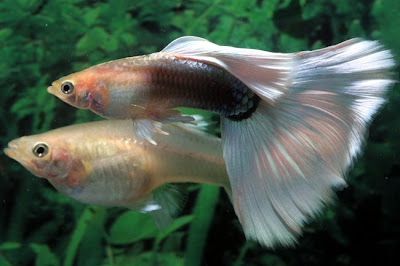Mollies are Live-bearers and are of different types and varieties - Black Molly, Black Moon Tail Molly, Silver Molly, Silver Moon Tail Molly, Red Eye Golden Velifera Molly, Sunrise Molly, Chocolate Molly, Balloon Molly, Marble Molly, Dalmation Molly etc. This is the common breeding system for different types of MOLLIES.
What you need
What you need
- Tank
- 24x12x12 inch Glass Tank - 2
- 1 for Breeding of Parents
- 1 for Baby Mollies
- 24x12x12 inch Wooden Top with 6W T4 Tube Light fitted - 1
- Life Support
- Air Pump - 1
- U G Filter - 2 (one for each tank)
- Interior Decor
- Fine Gravel or Sand Chips - 8 + 8 Kgs for each tank
- Live Water Plants - Cabomba / Mint / Ambulia - 25 bunch for each tank
- Food
- Basic FLAKEs and DRY WORMS for Adult Molly
- Micro PELLETs and DRY WORMS for Young Molly
- Parents
- 1:2 ratio of Male:Female Mollies i.e., Maximum 15 Mollies with 5 males and 10 females
- Aquarium Setup
- Setup the Aquarium tank with required item nos. in 1 to 3.
- Keep both the Glass Tanks nearby each other (possibly).
- Fix the Air Pump in a higher level.
- On both tanks, setup Life Support and Interior Decorations and connect to the Single Air Pump with both the U G Filters and fill-up water.
- The babies tank needs no top or artificial lighting, but, let the baby tank be positioned in such a place where natural light is available.
- Leave this setup with light and air pump ON for 10 to 15 days until the live plants grow their roots and get gripped.
- Enter the Molly
- On the 15th day, introduce the Parent Mollies at the ratio of 1:2 males and females in the breeding tank.
- For BETTER BREEDING & TO GAIN MORE NUMBER OF MOLLY BABIES, don't mix/put OTHER VARIETIES OF FISHES IN THE BREEDING TANK.
- Introducing other fishes will affect the privacy of Molly pairs & reduce the number of babies and at times may cause the birth of pre-mature babies or dead babies.
- Male/Female Identification
- Female looks bulkier in the abdomen and larger than the males. The Anal fin of the Female is like a quarter circular fan.
- Males are slim and have larger Dorsal fin. They have GONOPODIUM in the Anal Fin. GONOPODIUM is a tube like organ, which inserts sperm into female's body/Ovary to fertilize eggs. The Male can bend/turn his Gonopodium at 360 degree direction when mating with female.
- Prepping the Mollies for Breeding
- Water in the tank gets evaporated frequently, hence, needs refilling the evaporated space.
- Partly replacing the fresh water will motivate the Male Mollies to chase the Females.
- Feed the parents 3 times daily with highly nutritious food, like, Basic FLAKEs and DRY WORMS to get them healthy in the breeding condition.
- In a 10 days time, you can notice the Female Mollies are pregnant.
- Due to the fertiled eggs starts to grow, the belly of the Female will swell like a ball.
- Remove any waste plants and dust to keep the tank clean.
- Delivery
- When in labor, the female will never take food, but, after delivering babies, it may be more hungry and even it might have eaten its own young.
- Males will chase the Females vigourously to support them in labor.
- Females will feel shy and will hide in the water plants while giving birth. So, it is rare to notice the delivery of the Baby Mollies.
- Mothers will release its babies directly by twisting her body.
- Molly babies emerge from the Live Plants & Algae:
- HAPPY BIRTHDAY TO BABY MOLLIES!
- CONGRATS TO PARENTS & YOU TOO!
- Molly babies can be seen by our naked eyes immediately.
- Live Plants and Algae are the best bet in hiding the babies.
- Algae grow along with the plants will help to hide the Mother while breeding and the babies immediately after birth.
- Live Plants and Algae also serve as good natural feed for mother and babies.
- A Female could yield 5 to 50 young mollies at a time, as per its age and size once in every 30 days.
- Safer Home for Young Mollies
- Next day, move the Mollies to the second tank already kept ready.
- Once in a week, recycle 30% of the water carefully from the baby molly tank.
- Feeding
- Being the Live Bearers, the Molly Babies don't have yolk sack. So, from the day of birth onwards you may feed Micro PELLETS or DRY WORMS.
- Mollies are Live Bearers, i.e., they will give birth to Live Babies directly and do not lay eggs.
- As already mentioned Mollies are sensitive in nature, so, if we disturb the Mollies while they are pregnant, it will result in premature or dead babies.
- Breeding period of a female molly is generally 30 to 35 days.
- Breeding tank can be used for 1 year by recycling the water 50% once in a week.
- You can rear young mollies every month from a healthy mothers.






































